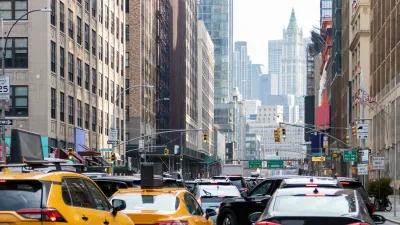In his latest entry in KCET's "Laws That Shaped LA" Series, Jeremy Rosenberg looks at the impact that the Functional Classification system has had on the urban form of Los Angeles and cities throughout the country since its adoption in 1973.
With the help of John Norquist, President and CEO of The Congress for the New Urbanism, who nominated the "Functional Classification Guidelines" for inclusion in Rosenberg's series, the reporter looks at how the "deceptively innocuous-sounding" guidelines helped advance sprawl and destroy urban landscapes by single-mindedly focusing the functionality of streets around accommodating auto movement.
"A successful street, Norquist says, must serve as: a path on which people travel, a place that facilitates the buying and selling of goods and services, and a public gathering spot." However, the Functional Classification system, which was "spelled out in a 1968 Department of Transportation study manual and then adopted into law as part of the Federal-Aid Highway Act of 1973," led public agencies to "focus on -- and fund accordingly -- street projects that put movement first..."
The result? "Sprawl happened. Interstates went right through cities, not around them. Significantly wider surface streets were constructed. Historic and other older buildings were sacrificed for more asphalt lanes. Urban cores split and sputtered. Commerce stalled. Tax receipts declined. People's daily lives intersected less. Suburban big box retail replaced mixed-use Main Streets. Life in less sustainable suburbia started to make sense. Populations fled."
So what is the antidote to movement? Congestion, as Norquist argued in a recent op-ed for Planetizen. "[E]ven at its worst, moving slower on a narrower road through a happening and engaged city far outweighs the alternative that the Functional Classification has for so long promoted."
FULL STORY: Sprawl: What Happens When You Legislate Against Vibrant Streets

Alabama: Trump Terminates Settlements for Black Communities Harmed By Raw Sewage
Trump deemed the landmark civil rights agreement “illegal DEI and environmental justice policy.”

Planetizen Federal Action Tracker
A weekly monitor of how Trump’s orders and actions are impacting planners and planning in America.

The 120 Year Old Tiny Home Villages That Sheltered San Francisco’s Earthquake Refugees
More than a century ago, San Francisco mobilized to house thousands of residents displaced by the 1906 earthquake. Could their strategy offer a model for the present?

Ken Jennings Launches Transit Web Series
The Jeopardy champ wants you to ride public transit.

BLM To Rescind Public Lands Rule
The change will downgrade conservation, once again putting federal land at risk for mining and other extractive uses.

Indy Neighborhood Group Builds Temporary Multi-Use Path
Community members, aided in part by funding from the city, repurposed a vehicle lane to create a protected bike and pedestrian path for the summer season.
Urban Design for Planners 1: Software Tools
This six-course series explores essential urban design concepts using open source software and equips planners with the tools they need to participate fully in the urban design process.
Planning for Universal Design
Learn the tools for implementing Universal Design in planning regulations.
Clanton & Associates, Inc.
Jessamine County Fiscal Court
Institute for Housing and Urban Development Studies (IHS)
City of Grandview
Harvard GSD Executive Education
Toledo-Lucas County Plan Commissions
Salt Lake City
NYU Wagner Graduate School of Public Service




























